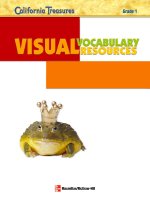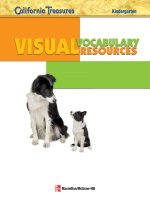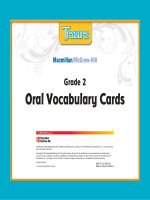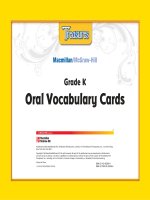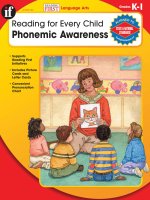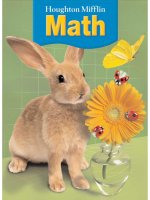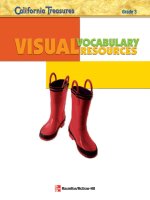visual vocabulary resources grade k
Bạn đang xem bản rút gọn của tài liệu. Xem và tải ngay bản đầy đủ của tài liệu tại đây (21.21 MB, 425 trang )
Kindergarten
B
Published by Macmillan/McGraw-Hill, of McGraw-Hill Education, a division of The McGraw-Hill Companies, Inc.,
Two Penn Plaza, New York, New York 10121
Copyright © by The McGraw-Hill Companies, Inc. All rights reserved. These Visual Vocabulary Resources may be
displayed in a classroom setting for use with Treasures, provided such display includes a copyright notice in the name
of Macmillan/McGraw-Hill. No other use of these Visual Vocabulary Resources is permitted without the prior written
consent of The McGraw-Hill Companies, Inc., including, but not limited to, network storage or transmission, or
broadcast for distance learning.
Printed in the United States of America
2 3 4 5 6 7 8 9 10 071 12 11 10 09
cover photography credits:
(t) MedioImages/Getty Images; (bl) Creatas Images/Jupiterimages; (br) SW Productions/Getty Images.
Program Author
Dr. Diane August
Educational Researcher
Principal Investigator, Developing Literacy in Second-Language
Learners: Report of the National Literacy Panel on Language-
Minority Children and Youth
Member of the New Standards Literacy Project, Grades 4-5
Program Consultant
Dr. Cheryl Dressler
Literacy Consultant- English Learners
•
•
Unit 1
Week 1 Key Vocabulary 1
Function Words and Phrases 7
Basic Words 9
Week 2 Key Vocabulary 11
Function Words and Phrases 17
Basic Words 19
Week 3 Key Vocabulary 21
Function Words and Phrases 27
Basic Words 29
Unit 2
Week 1 Key Vocabulary 31
Function Words and Phrases 37
Basic Words 39
Week 2 Key Vocabulary 41
Function Words and Phrases 47
Basic Words 49
Week 3 Key Vocabulary 51
Function Words and Phrases 57
Basic Words 59
Unit 3
Week 1 Key Vocabulary 61
Function Words and Phrases 67
Basic Words 69
Week 2 Key Vocabulary 71
Function Words and Phrases 77
Basic Words 79
Week 3 Key Vocabulary 81
Function Words and Phrases 87
Basic Words 89
Unit 4
Week 1 Key Vocabulary 91
Function Words and Phrases 97
Basic Words 99
Week 2 Key Vocabulary 101
Function Words and Phrases 107
Basic Words 109
Week 3 Key Vocabulary 111
Function Words and Phrases 117
Basic Words 119
Unit 5
Week 1 Key Vocabulary 121
Function Words and Phrases 127
Basic Words 129
Week 2 Key Vocabulary 131
Function Words and Phrases 137
Basic Words 139
Week 3 Key Vocabulary 141
Function Words and Phrases 147
Basic Words 149
Unit 6
Week 1 Key Vocabulary 151
Function Words and Phrases 157
Basic Words 159
Week 2 Key Vocabulary 161
Function Words and Phrases 167
Basic Words 169
Week 3 Key Vocabulary 171
Function Words and Phrases 177
Basic Words 179
Unit 7
Week 1 Key Vocabulary 181
Function Words and Phrases 187
Basic Words 189
Week 2 Key Vocabulary 191
Function Words and Phrases 197
Basic Words 199
Week 3 Key Vocabulary 201
Function Words and Phrases 207
Basic Words 209
Unit 8
Week 1 Key Vocabulary 211
Function Words and Phrases 217
Basic Words 219
Week 2 Key Vocabulary 221
Function Words and Phrases 227
Basic Words 229
Week 3 Key Vocabulary 231
Function Words and Phrases 237
Basic Words 239
Unit 9
Week 1 Key Vocabulary 241
Function Words and Phrases 247
Basic Words 249
Week 2 Key Vocabulary 251
Function Words and Phrases 257
Basic Words 259
Week 3 Key Vocabulary 261
Function Words and Phrases 267
Basic Words 269
Unit 10
Week 1 Key Vocabulary 271
Function Words and Phrases 277
Basic Words 279
Week 2 Key Vocabulary 281
Function Words and Phrases 287
Basic Words 289
Week 3 Key Vocabulary 291
Function Words and Phrases 297
Basic Words 299
English Language Development Vocabulary 300A
Contents
Function Words and Phrases
Unit 3 Week 3 Duck on a Bike
Word 1
toward
Word 2
past
Key Vocabulary
Unit 2 Week 2 Fr
iends All Around
Word 1
assist
Word 2
game
A
K
VVR
_
C
A_
U
2
W2
_
R
D
1
0
_
ke
y.
i
n
d
d
4
1
mouth eye tail
face wing nose
© MacMillan McGraw-Hill • photo credits: (tl) © Purestock/PunchStock. (tc) © Ingram Publishing/Fotosearch Stock Photography. (tr) © Brand X Pictures/PunchStock.
(bl) © Brand X Pictures/PunchStock. (bm) © Jeremy Woodhouse/Getty Images. (br) © Digital Vision/PunchStock.
1. Display the card.
2. Defi ne each word in English, referring to the photograph.
Incorporate actions where appropriate.
3. Have children say the word three times.
4. Explain how these six words fi t into a group, or category. During
independent work time, have children write sentences for each word.
ROUTINE
Basic Words
Unit 1 Week 1
Whose Baby Am I?
mouth, eye, tail,
face, wing, nose
9
Purpose and Use
The Visual Vocabulary Resources book provides teachers using the Macmillan/McGraw-Hill California
Treasures reading program photo-word cards that visually introduce specific vocabulary from the
program. The photos are intended to preteach vocabulary to English learners and Approaching Level
students, as well as offer additional, meaningful language and concept support to these students.
The photo-word cards are designed to interrelate with the English Learners and Approaching Small
Groups lessons and the English Learner Resource lessons, all of which are designed to support the EL
and struggling reader population. The Visual Vocabulary Resources book is referenced specifically in
those lessons.
Vocabulary Words
In the first half of the book, the photo-word cards support three categories of vocabulary in the core
reading program:
1. Key Vocabulary These are the Key Words as introduced to the entire class in the Oral Vocabulary
Card selections or the core sele ction. Students of all levels of language acquisition are taught these
words: Beginning, Early Intermediate, Intermediate, and Early Advanced.
2. Function Words and Phrases These are idioms, adverbs, two-word verbs, and other words
and phrases of particular use to English learners. Function Words and Phrases are also drawn
from the core selection, but will not be taught to the whole group as part of the core lesson.
Students of all levels of language acquisition are taught these words: Beginning, Early
Intermediate, Intermediate, and Early Advanced.
3. Basic Words These words are chosen from the Read Aloud Anthology, the core selection, or
the Kindergarten Literature Big Book. They have been chosen to fit a specific thematic category
that will help EL learners increase their depth of vocabulary. These words are not singled out for
instruction to the whole group. Only students at the Beginning and Early Intermediate levels of
language acquisition are taught these words.
The second half of the book suppor ts the vocabulary presented in the English Language
Development component of the California Treasures reading program. The ELD Vocabulary
presented is selected from the weekly Skill-Based English Learners Practice Reader. In the place of
the Basic Words categories, there are Content Words drawn from ELD Content Big Book selections.
Structure of Book
The Key Vocabulary and Function Words and Phrases sections both have two photos on each right-hand
page. Each photo represents one vocabulary word. The teacher script is located on the back of each
card direc tly behind its accompanying photo. The Basic Words section shows six photos per page,
followed by a teacher routine. The ELD Content Words section mimics this format with 4 to 6 words per
page.
Teacher Scripts
The lessons found on the Key Vocabulary, Function Words and Phrases, and ELD Vocabulary se ctions are
interactive in approach. They define the vocabulary words in English and Spanish, point out cognates
(where appropriate), and provide strategies to get students talking and using the new language as
much as possible; for example students:
chorally pronounce the word to focus on articulation
partner talk with structure d sentence frames to use the word in oral speech
role-play to make the word come to life and use in everyday situations
connect the word to known words and phrases through sentence replacement activities
engage in movement activities to experience the word’s meaning
The techniques make instruction engaging and me morable for students. These low-risk ways to practice
speaking help students make connections and develop unders tanding as they acquire vocabular y.
•
•
•
•
•
How to
Use this Book
Visual Vocabulary Resources—A New Classroom Resource
iv
Key Vocabulary
Unit 1 Week 1 Whose Baby Am I?
Word 1 animal
Word 2 imitate
© Macmillan/McGraw-Hill • photo credits: (t) © Jeremy Woodhouse/Digital Vision/Getty Images. (b) © Mark Karrass/Royalty-Free/Corbis.
Key Vocabulary
Unit 1 Week 1 Whose Baby Am I?
TEACHER TALK
Point to the Word 1 image on the opposite side.
1. One word in the selection is animal. Say it
with me: animal. An animal is a living thing
that takes in food and can move about. Dogs,
lions, birds, and fi sh are all animals.
2. En español, animal quiere decir “un ser
viviente que come y se mueve.” Los perros,
leones, pájaros y peces son animales.
3. Animal in English and animal in Spanish are
cognates. They sound almost the same and
mean the same thing in both languages.
4. Now let’s look at the picture. This is a coyote.
A coyote looks somewhat like a dog or a wolf.
The coyote moves about looking for food to
eat. The coyote is a wild animal.
5. Let’s pretend to be the coyote in the picture.
Let’s do what this animal does. (Lead children
in barking and panting. You may also want
to let them get on their hands and knees and
pretend to move like a coyote.)
6. We will play a guessing game. I will pretend
to be an animal. You pretend to be that
animal, too. We will use this sentence to tell
what animal we are pretending to be: This
animal is a
. (Act out obvious
animal movements such as a bird fl apping its
wings and a cat stretching.)
7. Now let’s say animal together three more
times: animal, animal, animal.
Word 1 animal
Word 2 imitate
Point to the Word 2 image on the opposite side.
1. Another word in the selection is imitate. Say
it with me: imitate. To imitate means “to
copy what someone does.” Imagine that your
friend makes a funny face. Imagine that you
make the same face. You imitate your friend.
2. En español, to imitate quiere decir “imitar o
copiar lo que hace otra persona.”Imagina que
tu amigo hace una mueca. Ahora imagina que
tu haces la misma mueca. Tu imitaste a tu
amigo.
3. To imitate in English and imitar in Spanish are
cognates. They sound almost the same and
mean the same thing in both languages.
4. Now let’s look at the picture. The big boy
plays a fl ute. The little boy also plays a fl ute.
The little boy does the same thing the big boy
does. The little boy imitates the big boy.
5. We will play a game called “Follow the
Leader.” I will be the leader. I will do an
action. You will copy what I do. You will
imitate me. (Do actions such as marching,
hopping, and clapping for children to imitate.)
6. You will work with a partner. Each of you will
draw something. You might draw an animal
or a toy. Then your partner will look at your
drawing and draw the same thing. Your
partner will imitate your drawing.
7. Now let’s say imitate together three more
times: imitate, imitate, imitate.
MOVEMENTTEACHER TALK
MOVEMENT
Key Vocabulary
2
Key Vocabulary
Unit 1 Week 1 Whose Baby Am I?
Word 3 protect
Word 4 resemble
© Macmillan/McGraw-Hill • photo credits: (t) © Creatas Images/Jupiterimages. (b) © Creatas Images/Jupiterimages.
Key Vocabulary
Word 3
protect
Point to the Word 3 image on the opposite side.
1. Another word in the selection is protect. Say it
with me: protect. To protect means “to keep a
person or thing safe.” Our actions can protect
us. We wash our hands to protect ourselves
from getting sick. Things can protect us, too.
Umbrellas protect us from the rain.
2. En español, to protect quiere decir “mantener
a una persona o cosa fuera de peligro,
proteger.” Nuestras acciones nos pueden
proteger. Nos lavamos las manos para
protegernos de enfermedades. Usamos
paraguas o sombrillas para protegernos de la
lluvia.
3. To protect in English and proteger in Spanish
are cognates. They sound almost the same
and mean the same thing in both languages.
4. Now let’s look at the picture. The girl is
putting on a hard hat called a helmet. (Point
to the helmet.) The helmet will protect her
head if she falls off her bike.
5. We protect ourselves from the weather. We
use things to keep us safe and comfortable in
cold, hot, or wet weather. Talk to your partner
about things we use to protect ourselves
from the weather. Use this sentence frame:
protect us in cold weather.
(Examples: boots, mittens, hats)
6. We want everyone in our school to be safe.
That is why we have rules to protect us. Talk
with your partner about school rules that keep
us safe. (Examples: Don’t run in the halls. Stay
in the schoolyard.)
7. Now let’s say protect together three more
times: protect, protect, protect.
PARTNER TALK
Word 4 resemble
TEACHER TALK MOVEMENT
Point to the Word 4 image on the opposite side.
1. Another word in the selection is resemble. Say
it with me: resemble. To resemble means “to
look like something else.” A red ball could
resemble an apple. They would be the same
color, shape, and size. But they would not be
exactly alike.
2. En español, to resemble quiere decir
“parecerse, verse parecido a otra cosa.” Una
pelota roja puede parecerse a una manzana.
Tienen el mismo color, la misma forma, y el
mismo tamaño. Pero no son exactamente
iguales.
3. Now let’s look at the picture. The picture
shows two dogs. The dogs are not exactly
the same, but they resemble each other. Both
dogs have black heads, black back legs, and
black backs. Both dogs have white front legs
and white chests.
4. Each of you will have a chance to pick
someone in our class who resembles you.
When it is your turn, go stand next to
someone you think resembles you. Then tell us
how your classmate resembles you. (Examples:
We both are the same size. We have the same
haircut. We have the same color hair and
eyes.)
5. I will give you a few minutes to look around
our classroom. Look for two things that
resemble each other. Then show the two
things to the class. Use these sentences
frames to tell us about the two things:
resembles .
They both .
6. Now let’s say resemble together three more
times: resemble, resemble, resemble.
Key Vocabulary
Unit 1 Week 1 Whose Baby Am I?
TEACHER TALK
4
Key Vocabulary
Unit 1 Week 1 Whose Baby Am I?
Word 5 together
© Macmillan/McGraw-Hill • photo credits: (t) © Corbis Images/Jupiterimages.
Key Vocabulary
Unit 1 Week 1 Whose Baby Am I?
TEACHER TALK
Word 5 together
Point to the Word 5 image on the opposite side.
1. Another word in the selection is together.
Say it with me: together. Together means
“with someone or something else.” We work
with each other in our classroom. We work
together.
2. En español, together quiere decir “con otra
persona u otra cosa, juntos.” Trabajamos con
nuestros compañeros en la clase. Trabajamos
juntos.
3. Now let’s look at the picture. We see three
boys in this picture. They are all looking at
the same book. They are looking at the book
together.
4. Draw a picture of something you and your
friends do together. Show your picture to your
partner. Tell about the picture. Use the word
together.
5. We talked about how people can do things
together. Things can also be together.
For example, salt and pepper go together.
Paint and brushes go together. Tell your
partner some things that go together. Use
this sentence frame:
and
go together.
6. Now let’s say together three more times:
together, together, together.
PARTNER TALK
6
Function Words and Phrases
Unit 1 Week 1 Whose Baby Am I?
Word 1 hard
Word 2 easily
© Macmillan/McGraw-Hill • photo credits: (t) © Royalty-Free/Corbis. (b) © Steve Mason/Getty Images.
Word 1 hard
1. In English, we use the word hard to talk about
things that aren’t easy to do. Say it with me:
hard. Hard means “diffi cult to do.” It is hard
to lift a big, heavy box.
2. En español, hard quiere decir “difícil de
hacer.” Es difícil levantar una caja pesada.
3. This picture shows the word hard. The boys
are pulling hard on the rope. They are playing
a game called tug-of-war.
4. I am going to tell you about some things
people do. If I name something that is hard
to do, say “Hard!” If I name something that is
not hard to do, do not say anything.
putting together a big puzzle
eating a snack
building a house
5. Let’s pretend we are climbing a big mountain.
(Lead children in doing motions such as
stepping high and grabbing above with your
hands to simulate climbing.) We will chant as
we climb:
This is hard.
This is hard to do.
This is hard.
This is hard to do.
6. Repeat the word three times with me: hard,
hard, hard.
Word 2 easily
TEACHER TALK CHORAL RESPONSE
1. In English, we use the word easily to talk
about things we do that are not hard at all.
Say it with me: easily. Easily means “without
working hard.” You can easily say your name.
2. En español, easily quiere decir “fácilmente;
sin mucho esfuerzo.” Puedes decir tu nombre
fácilmente.
3. This picture shows the word easily. The girl is
going down a slide. She slides down easily. It’s
not hard for her to slide from top to bottom.
4. Let’s do some things that we can do easily.
We will say what we are doing using the word
easily. Let’s clap. Now let’s all say, “We can
clap easily.“ (Continue with other actions,
such as wave, smile, and blink.)
5. I am going to tell you about some other
things we do. If we do them easily, say the
word easily. If not, don’t say anything.
climb a mountain.
listen to a story.
carry a heavy package.
talk to a friend.
6. Repeat the word three times with me: easily,
easily, easily.
TEACHER TALK CHORAL RESPONSE
8
mouth eye tail
face wing nose
© Macmillan/McGraw-Hill • photo credits: (tl) © Purestock/PunchStock. (tc) © Ingram Publishing/Fotosearch Stock Photography. (tr) © Brand X Pictures/PunchStock.
(bl) © Brand X Pictures/PunchStock. (bm) © Jeremy Woodhouse/Getty Images. (br) © Digital Vision/PunchStock.
1. Display the card.
2. Defi ne each word in English, referring to the photograph.
Incorporate actions where appropriate.
3. Have children say the word three times.
4. Explain how these six words fi t into a group, or category. During
independent work time, have children write sentences for each word.
ROUTINE
Basic Words
Unit 1 Week 1
Whose Baby Am I?
mouth, eye, tail,
face, wing, nose
9
Word 2 cooperate
Key Vocabulary
Unit 1 Week 2 The Picnic at Apple Park
© Macmillan/McGraw-Hill • photo credits: (t) © SuperStock. (b) © Comstock Images/Alamy Images.
Key Vocabulary
Unit 1 Week 2 The Picnic at Apple Park
TEACHER TALK
Word 1 activity
Word 2 cooperate
TEACHER TALK
PARTNER TALK
PARTNER TALK
Point to the Word 1 image on the opposite side.
1. One word in the selection is activity. Say it
with me: activity. An activity is something you
do. You can do an activity by yourself or with
other people. One activity I like to do is read.
I usually read by myself. Another activity I like
to do is ride my bike. I usually ride my bike
with my family.
2. En español, activity quiere decir “una
acción que llevas acabo, una actividad.”
Una actividad que me gusta hacer es leer.
Normalmente leo solo. Otra actividad que
me gusta es montar en mi bici. Normalmente
monto en bicicleta con mi familia.
3. Activity in English and actividad in Spanish are
cognates. They sound almost the same and
mean the same thing in both languages.
4. Now let’s look at the picture. The picture shows
a teacher and two children. They are doing an
activity together. The activity is what they are
doing. This activity is drawing a picture.
5. What is an activity that you like to do? Act
out the activity for your partner. Have your
partner guess what the activity is.
6. Tell your partner what activities you like to do
at school. Then tell what activities you like to
do at home.
7. Now let’s say activity together three more
times: activity, activity, activity.
Point to the Word 2 image on the opposite side.
1. Another word in the selection is cooperate.
Say it with me: cooperate. To cooperate
means “to work together.” When you
cooperate with a friend, you work together
and help each other.
2. En español, to cooperate quiere decir “trabajar
junto con otras personas, cooperar.” Cuando
cooperas con un amigo, trabajan juntos y se
ayudan.
3. To cooperate in English and cooperar in Spanish
are cognates. They sound almost the same
and mean the same thing in both languages.
4. Now let’s look at the picture. These girls
cooperate. They work together to make a
sandcastle. The girls cooperate when they
put sand in the pail together. Then they
cooperate when they use the sand to make
the sandcastle.
5. Why is it important to cooperate at school?
Tell your partner. (When you cooperate you
get things done faster and better. It is more
fun when you cooperate.)
6. Complete the sentence for your partner: I
cooperate when I
.
7. Now let’s say cooperate together three more
times: cooperate, cooperate, cooperate.
Key Vocabulary
12
Key Vocabulary
Unit 1 Week 2 The Picnic at Apple Park
Word 3 exciting
Word 4 exhausted
© Macmillan/McGraw-Hill • photo credits: (t) © U.S. Air Force photo by John Van Winkle. (b) © Stockbyte/Getty Images.
Key Vocabulary
Unit 1 Week 2 The Picnic at Apple Park
Word 3 exciting
Word 4 exhausted
Point to the Word 3 image on the opposite side.
1. Another word in the selection is exciting. Say
it with me: exciting. If something is exciting,
you do not know what will happen. You want
to fi nd out. Some sports games are exciting.
The scores are so close that you want to fi nd
out who will win.
2. En español, exciting quiere decir
“emocionante, que causa sentimientos.”Algo
es emocionante porque no sabes que va a
pasar. Un partido puede ser emocionante.
Como no sabes que va a ocurrir, lo ves hasta
el fi nal para ver quién ganará.
3. Now let’s look at the picture. The picture
shows an exciting football game. The player
has the ball. I want to know what will
happen. Will the player score a touchdown?
Who will get the ball? People like to watch
exciting football games. The people want
their teams to win.
4. Let’s show what people do when they are
watching an exciting football game. First,
let’s jump up and down. Then let’s cheer for
the team. (Use an excited voice.) Hooray! This
game is exciting.
5. Pretend you are watching an exciting movie.
Show what you do when the movie gets really
exciting. Now show what you do if the movie
is not exciting at all.
6. Now let’s say exciting together three more
times: exciting, exciting, exciting.
TEACHER TALK
TEACHER TALK
MOVEMENT
MOVEMENT
Point to the Word 4 image on the opposite side.
1. Another word in the selection is exhausted.
Say it with me: exhausted. Exhausted means
“very, very tired.” (Yawn and look tired.)
Sometimes I am exhausted after I work hard
all day long. If I am really exhausted, I go
home and take a nap.
2. En español, exhausted quiere decir “estar
muy, muy cansado.” A veces quedo cansado
después de trabajar todo el día. Si estoy muy
cansado, me voy a mi casa y tomo una siesta.
3. Now let’s look at the picture. This woman is
exhausted. I think she has been running for
a long time. She is very, very tired now. She is
taking a rest. Do you see her eyes? They are
closed. She is leaning over, too. Some people
close their eyes or lean over when they are
exhausted.
4. Show me something you do when you are
exhausted. (Examples include: stretch, close
eyes to sleep, yawn, lie down, sit down with
head on desk.)
5. Pretend you are the woman in the picture.
You are exhausted. Show me what you will do
next.
6. Now let’s say exhausted together three more
times: exhausted, exhausted, exhausted.
Key Vocabulary
14
Key Vocabulary
Unit 1 Week 2 The Picnic at Apple Park
Word 5 gather
© Macmillan/McGraw-Hill • photo credits: (t) © Royalty-Free/Corbis.
Key Vocabulary
Unit 1 Week 2 The Picnic at Apple Park
MOVEMENTTEACHER TALK
Word 5 gather
Point to the Word 5 image on the opposite side.
1. Another word in the selection is gather. Say
it with me: gather. To gather means “to get
together in a group.” Sometimes you and your
friends gather at recess or before school. You
all stand together and talk or play.
2. En español, to gather quiere decir “reunir o
juntar a personas en un grupo.” A veces tú y
tus amigos se reúnen a la hora del recreo o
antes de clases. Se paran juntos y hablan o
juegan.
3. Now let’s look at the picture. The picture
shows penguins. All the penguins gather
in one place. That means that they all get
together in a group. In this picture, the
penguins gather in one place in the snow.
4. Let’s all gather over here by the window. Now
that we are gathered, are we all together?
Where else can we gather? Let’s all gather
there.
5. Now let’s gather in two groups. One group
can gather at the front of the room. The other
can gather at the back. Now complete this
sentence: We gather
.
6. Now let’s say gather together three more
times: gather, gather, gather.
16
Function Words and Phrases
Unit 1 Week 2 The Picnic at Apple Park
Word 1 go on
Word 2 go by
© Macmillan/McGraw-Hill • photo credits: (t) © Karl Weatherly/Getty Images. (b) © Jim Arbogast/Getty Images.
Word 1 go on
1. In English, we use go on when we talk about
taking a trip. Say it with me: go on. The class
will go on a trip to the park.
2. En español, usamos to go on cuando hablamos
de irnos de viaje o de tomar una excursión.
Nuestra clase tomará una excursion al parque.
3. This picture shows the words go on. The
mother, father, and daughter in this family
go on a camping trip. The family drives their
car to the beach. They put up a tent. After
camping a few days, they drive back home.
4. We will march around the room and chant.
(Lead children in marching and chanting.)
I will go on a trip to the sea.
Please go on the trip with me.
If you go on the trip with me,
Oh, what fun it will be!
5. Take turns telling the class where you want
to go on a school trip. Then we will all chant
what you say. Use this sentence:
I want to go on a trip to
. (Examples
include: park, zoo, beach)
6. Repeat the words three times with me: go on,
go on, go on.
Word 2 go by
TEACHER TALK CHORAL RESPONSE
1. In English, go by means to move past
something. Say it with me: go by. I saw a
school bus go by the school.
2. En español, to go by quiere decir “pasar por
un lugar.” Un autobús pasó por la escuela.
3. This picture shows the words go by. Let’s
pretend we are standing here. (Indicate a
point on the lower edge of the picture.)
We are standing on the street. The bikes are
riding on the same street. We can see the
bikes go by.
4. We will chant a silly chant about things we
can watch go by.
I saw a pink elephant go by.
Oh me, oh my!
I saw a purple cow go by.
Oh me, oh my!
(Have children suggest other silly lines for this
chant.)
5. Pretend you are looking out a window. Tell us
what you see go by. Use this sentence:
I see a
go by.
Then we will all chant your sentence.
6. Repeat the words three times with me: go by,
go by, go by.
TEACHER TALK CHORAL RESPONSE
18
basket game table
food quiltjuice
© Macmillan/McGraw-Hill • photo credits: (tl) © Ingram Publishing/Alamy Images. (tc) © Jack Star/PhotoLink/Getty Images. (tr) © Squared Studios/Getty Images.
(bl) © Ingram Publishing/Alamy Images. (bm) © Stockbyte/Getty Images. (br) © Photodisc/Getty Images.
1. Display the card.
2. Defi ne each word in English, referring to the photograph.
Incorporate actions where appropriate.
3. Have children say the word three times.
4. Explain how these six words fi t into a group, or category. During
independent work time, have children write sentences for each word.
ROUTINE
Basic Words
Unit 1 Week 2
The Picnic at Apple Park
basket, game, table,
juice, food, quilt
19
Unit 1 Week 3 Peter’s Chair
Word 1 celebrate
Word 2 change
